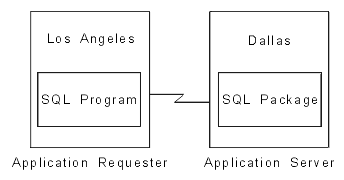Distributed relational database
A distributed relational database consists of a set of tables and other objects that are spread across different but interconnected computer systems or logical partitions on the same computer system. Each computer system has a relational database manager that manages the tables in its environment. The database managers communicate and cooperate with each other in a way that allows a database manager to execute SQL statements on another computer system.
Distributed relational databases are built on formal requester-server protocols and functions. An application requester supports the application end of a connection. It transforms a database request from the application into communication protocols suitable for use in the distributed database network. These requests are received and processed by an application server at the other end of the connection.1 Working together, the application requester and application server handle the communication and location considerations so that the application is isolated from these considerations and can operate as if it were accessing a local database. A simple distributed relational database environment is illustrated in Figure 1.

For more information about Distributed Relational Database Architecture™ (DRDA)
communication protocols, see Open
Group Publications: DRDA Vol.
1: Distributed
Relational Database Architecture (DRDA)